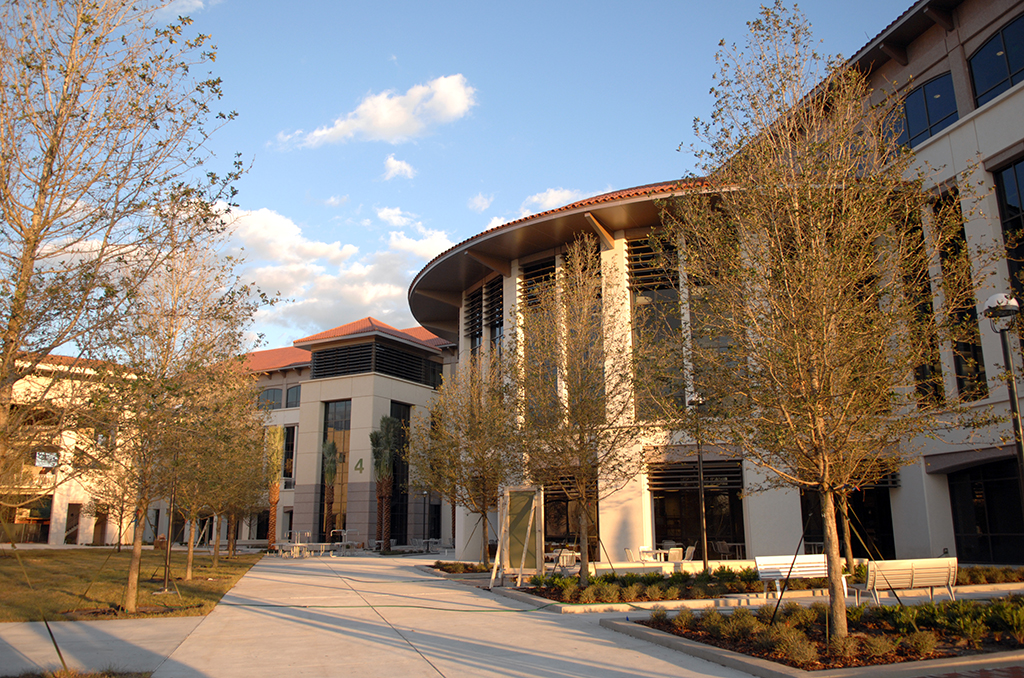On Jan. 2, officials at Valencia College’s Osceola Campus will open the doors to the campus’s newest building — and they’ll also usher in a new era at the Kissimmee campus.
Building 4 – a four-story, 150,000 square-foot building and the largest building on any Valencia campus – will not only give Osceola students a much bigger library, tutoring center and cafeteria, but it will expand their educational opportunities. Valencia College and the University of Central Florida will share use of the building, and UCF plans to eventually offer a dozen bachelor’s degrees at the Osceola Campus.
That sends a critical message to Osceola County residents – that a college education is attainable, even without leaving home, says Dr. Kathleen Plinske. And that’s important in Osceola, where high school graduates are less likely to go on to college than students in other Central Florida counties, she added.
UCF, which operates a regional campus at Valencia’s Osceola Campus, already offers seven degrees at the Kissimmee campus, ranging from business to political science. By fall 2013, UCF plans to add a diverse array of bachelor’s degrees to the Osceola campus, including degrees in biomedical science, criminal justice, psychology, public administration and health services administration.
Plinske is particularly excited about the upcoming degree in biomedical science. “It’s the perfect degree for a student who wants to go on to medical school,” says Plinske.
And at a time when state officials are urging more students to study STEM – science, technology, engineering and mathematics – Osceola’s new building will enable campus officials to offer more classes in biology, chemistry and physics. The new labs include three anatomy and physiology labs, three biology labs, two chemistry labs, one microbiology lab and one physics lab.
Designed by architectural firm Hunton-Brady and built by contractor Clancy & Theys, Building 4 cost $35 million in construction costs. UCF, which will share the building, contributed $7.5 million. In addition to the use of classrooms, UCF will also have 18 offices for faculty and administrative staffers in Building 4.
Designed in California “mission style,” the building is also likely to become the hub of campus life for the 12,500 students who take classes at the Osceola campus. That’s because Building 4, in addition to housing classrooms and science lab, will also be home to many student services, including the campus library, bookstore, cafeteria and a coffee bar.
Before designing the new building, the architects and builders worked with Plinske to create an environment that meets the needs of many students.
That’s why the new library — which is nearly twice the size of the current library — features areas for silent study and glass-enclosed group study rooms. In the main reading room, the furniture will be comfortable and conducive to reading. “It’ll feel more like coffee shop, not a traditional library,” Plinske said .
Plinske wanted to give students at this commuter campus plenty of places to sit, study and relax — and that’s been one of the driving forces in the design of Building 4′s interior and exterior. Outside the first floor, in the shadow of the building, benches, courtyard spaces and a fountain area are strategically located so that they’ll be in shade much of the day. On the second floor, a terrace — complete with tables and chairs — overlooks the lawn. “This is a great space for students to study and to just hang out,” Plinske said.
Other innovative features include:
- a “green screen” room where students and faculty members can create their own videos for use in presentations;
- outdoor learning spaces that feature benches and glass boards, complete with markers;
- large science-related murals, such as a giant mural of the periodic table of elements;
- and a multipurpose room next to the bookstore, which allows the bookstore to expand during times of heavy use, such as book buyback periods.

Comments are closed.